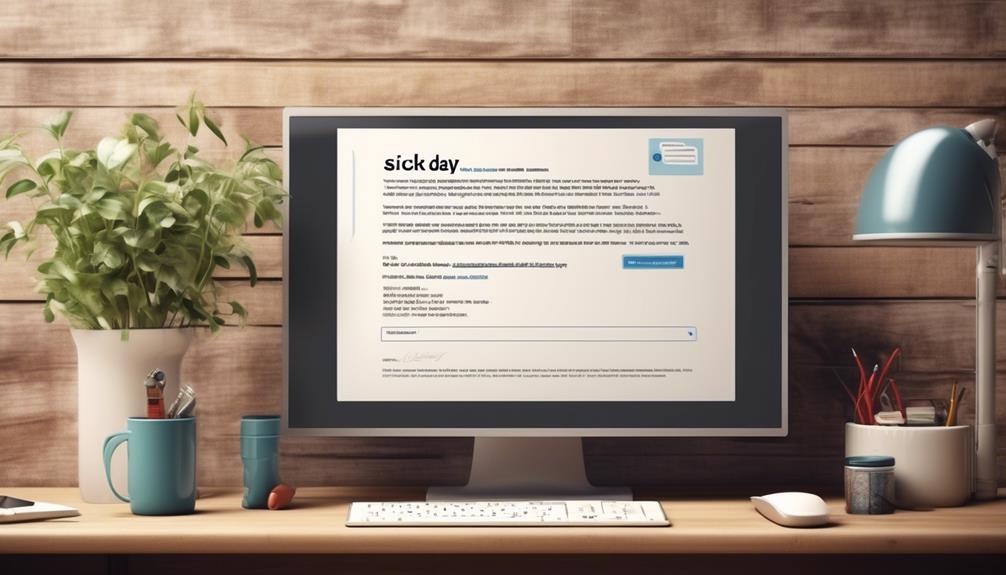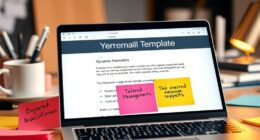Crafting an email to a teacher requires precision and thoughtfulness. It’s not merely about stringing words together; it’s about constructing a message that’s professional and impactful. Paying attention to the subtle dos and don’ts of email etiquette can significantly influence the kind of impression we make.
In our digital age, the ability to express ourselves clearly and respectfully through email is a valuable skill that can open doors to better understanding and support from our teachers. So, how can we ensure our emails strike the right chord and convey our thoughts with finesse?
Let's explore the keys to composing impactful and polished emails that will earn us the respect and attention of our teachers.
Key Takeaways
- Clear and concise subject lines are crucial for effective communication with teachers.
- Proper greetings and salutations, using correct titles and last names, demonstrate professionalism and respect.
- Emails should follow a formal structure, similar to a formal letter, and should be kept concise and focused.
- Maintaining a respectful tone throughout the email, including positive feedback or expressions of gratitude, is important for effective communication with teachers.
Subject Line Importance
Understanding the significance of a clear and concise subject line is essential when composing an email to a teacher. The subject line serves as a gateway, providing the teacher with an immediate understanding of the email's content and purpose.
When crafting the subject line, it's crucial to include your name, class, and specific assignment title if applicable. This information helps the teacher quickly identify and prioritize your email amidst the multitude of messages they receive. A well-crafted subject line not only demonstrates professionalism but also conveys respect for the teacher's time.
By including pertinent details in the subject line, such as your name and the specific reason for the email, you can ensure that the teacher can efficiently manage their inbox and address your needs. Furthermore, a concise and informative subject line can encourage the teacher to open and respond to your email promptly.
Therefore, when writing emails to teachers, a clear subject line is a fundamental aspect that shouldn't be overlooked.
Proper Greeting and Salutation

We always address our teacher formally with a proper salutation such as 'Dear Mr./Ms./Mrs. [Last Name]' to show respect and professionalism. When writing an email to a professor or a high school teacher, it's important to follow the guidelines for a formal email. Here are some key points to consider when crafting your greeting and salutation:
- Use the Correct Title and Last Name: Address the teacher using their preferred title and last name, such as 'Dear Professor Smith' or 'Dear Ms. Johnson'. This demonstrates respect and acknowledges their position.
- Reflect the Formality of the Email: Tailor your greeting to match the level of formality appropriate for the teacher-student relationship. For instance, 'Hello [First Name]' might be suitable for a more casual interaction, while 'Dear Dr. [Last Name]' is more fitting for a formal inquiry.
- Choose a Professional Tone: Avoid overly casual language and informal salutations. Instead, opt for a respectful and professional tone to set the right impression from the beginning of the email.
When closing your email, remember to maintain the same level of professionalism by using a proper closing, such as 'Sincerely' or 'Best regards'. This attention to detail in your salutation and closing helps to uphold email etiquette and convey your respect for the teacher.
Formal Structure and Content
Upon establishing a respectful and professional salutation, the next crucial aspect to consider is the formal structure and content of the email when communicating with a teacher.
When writing an email to a teacher, it's essential to make sure that the email address used is the official school email, as this maintains a formal and professional approach. The subject line should include relevant information, such as your name, class, and assignment title, to provide a clear summary of the email's purpose.
Additionally, the body of the email should be structured like a formal letter, with proper formatting and a focus on maintaining a respectful and professional tone throughout. It's important to address the teacher using appropriate titles and last names, such as 'Dear Mr./Ms./Mrs. [Last Name],' unless the teacher has explicitly stated otherwise. When including a proper salutation, avoid using the teacher's first name unless they've given permission to do so.
Moreover, the email should be concise, focused, and free from personal language, ensuring that only necessary information is included.
Lastly, always end an email with a professional closing, such as 'Sincerely' or 'Best regards,' and include a proper signature with your full name and class details. For further guidance, referring to email samples can be beneficial in understanding the appropriate formal structure and content.
Maintaining a Respectful Tone

Maintaining a respectful tone in email communication with a teacher is essential for fostering a professional and courteous exchange. When sending an email, it's important to write with appropriate salutations, such as starting with 'Dear Mr./Ms./Mrs. [Last Name].' Additionally, providing positive feedback or expressing gratitude can help set a respectful tone from the outset.
Being clear and concise in your communication is crucial, whether you're asking a question or seeking assistance. Remember that the teacher knows you're reaching out for help, so maintaining a respectful and polite tone throughout the email is key.
Furthermore, if you need to write a follow-up email, ensure that the same level of respect and professionalism is maintained. By following these guidelines, you can ensure that your email communication with your teacher remains respectful and contributes to a positive and productive learning environment.
Effective Email Sending and Reviewing
Emailing teachers offers a convenient and efficient way to communicate outside of office hours, allowing students to ask questions or seek assistance as needed. When sending emails every day, it's important to be mindful of the teacher's time by keeping them concise and to the point. Below is a table summarizing the key points to remember when sending an email to your teacher for the first time.
| Key Points | |
|---|---|
| Use an Appropriate Subject Line | Include your full name, class, and assignment title if applicable. |
| Address the Teacher Formally | Use an appropriate salutation and address your teacher respectfully. |
| Proofread Before Sending | Check for spelling, grammar, and tone to ensure professionalism. |
| Maintain a Professional Tone | Keep the email respectful and stick to discussing school-related matters. |
| Request Confirmation | If there is an assignment due or if you are unable to attend class, request confirmation of receipt or understanding. |
When reviewing your email, ensure that it is clear, respectful, and free from typos. As a student, I would appreciate receiving clear and concise emails, so it's essential to apply the same standard when reaching out to my teachers.
What Are the Key Components of a Properly Written Email to a Teacher?
When emailing a teacher, using proper email writing tips is essential. Begin with a clear and concise subject line. Address the teacher respectfully and briefly state the purpose of the email. Use a professional tone and proofread for grammar and spelling errors. Always conclude with a polite closing.
Frequently Asked Questions
How Do You Start an Email to a Teacher?
When we start an email to a teacher, it’s important to be respectful and professional. We typically begin with a polite greeting, such as ‘Dear [Teacher’s Name]’ or ‘Hello [Teacher’s Name]’. This sets a courteous tone for the rest of the email. It’s also important to clearly state the purpose of the email and to use proper grammar and punctuation. Additionally, it’s helpful to express gratitude, such as by saying “Thank you for your time” or “I appreciate your assistance”. If unsure of the proper etiquette, there are many resources available on how to write a polite email that can provide guidance and tips.
It's also a good idea to include a brief introduction of who we're and the reason for contacting the teacher. This helps to establish clear communication from the beginning.
How Do I Write an Email to My Child's Teacher?
We write to our child's teacher with respect and professionalism. It's important to address the teacher formally, keep the email concise, and use our school-assigned email address.
We should also be mindful of the teacher's time and avoid using casual or disrespectful language. When emailing, we strive for a professional tone, check for typos, and ensure clarity.
This approach helps us maintain a positive and effective communication with our child's teacher.
What Does a Good Email to a Teacher Look Like?
A good email to a teacher includes a clear subject line with relevant details. It should also have a formal salutation and provide context in the body. Maintaining a professional yet concise tone is important. It is crucial to proofread the email for clarity and correctness before hitting 'send'. This ensures effective communication and displays respect for the teacher's time. Always use a professional tone and avoid ambiguity. Remember, a well-crafted email can positively impact your relationship with your teacher and ultimately, your academic success.
How Do I Send an Email to a Teacher on Gmail?
We send an email to a teacher on Gmail by composing a new email and entering the teacher's email address in the 'To' field.
It's important to use a clear and concise subject line that includes our name, class, and assignment title if applicable.
We should also maintain a professional and respectful tone, address the teacher formally, and proofread our email for any errors before hitting send.
Conclusion
In conclusion, writing an email to a teacher requires attention to detail and professionalism.
From the subject line to the content and tone, each aspect must be carefully considered to ensure clear and effective communication.
By following the guidelines provided, students can confidently and respectfully communicate with their teachers, fostering a positive and productive academic environment.









